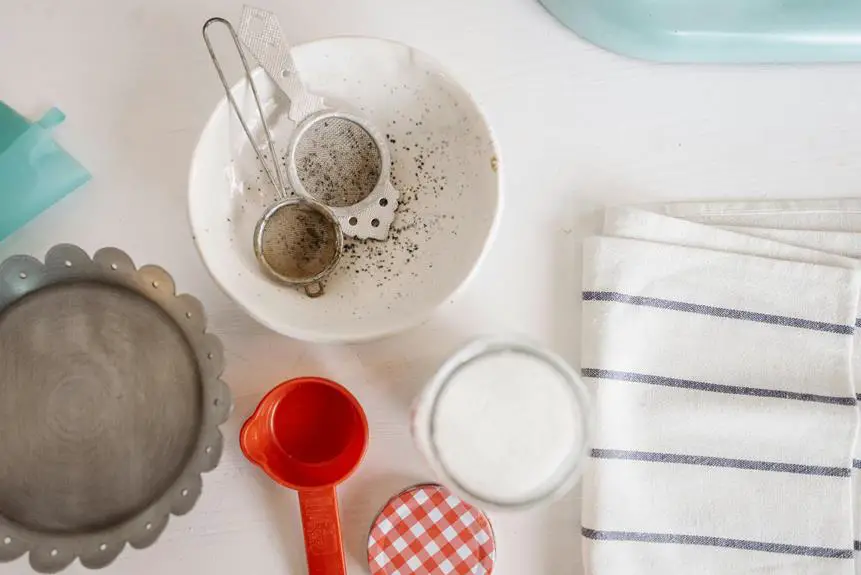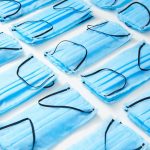When you're planning to bleach fabric safely, having the right tools is crucial to protect yourself and achieve the best results. You'll want to start with essential protective gear like gloves and goggles to minimize exposure to harsh chemicals. Accurate measuring tools and sturdy mixing containers can help you maintain the correct bleach-to-water ratios, while proper application tools ensure even coverage. But that's just the beginning; there are several other considerations that can enhance your bleaching experience and keep you safe. Curious about what else you might need?
Table of Contents
Key Takeaways
- Use nitrile or latex gloves, goggles, and masks to protect against skin irritation, eye exposure, and harmful fumes during bleaching.
- Accurate measuring tools and sturdy mixing containers ensure proper bleach-to-water ratios for effective and safe application.
- Choose appropriate application tools like sponge brushes or spray bottles for controlled and even bleaching on fabrics.
- Ensure proper ventilation by opening windows, using fans, and avoiding enclosed spaces to disperse harmful bleach fumes.
Protective Gear Essentials
When you're bleaching fabric, wearing the right protective gear is essential to keep yourself safe from harmful chemicals.
First and foremost, invest in a good pair of gloves. Nitrile or latex gloves provide a barrier between your skin and the bleach, preventing irritation or burns. Make sure you choose gloves that fit snugly but comfortably, allowing you to handle materials without slipping.
Next, consider wearing protective goggles. Bleach can splash, and you don't want to risk getting it in your eyes. Goggles will shield your eyes from any accidental splashes, ensuring you can work safely.
A mask is also a smart addition. The fumes from bleach can be strong and irritating, especially in poorly ventilated spaces. A mask will help filter out those fumes, making the experience more comfortable.
Lastly, wear old clothing or an apron that you don't mind getting stained. Bleach can ruin your favorite outfits, so protect them while you work.
Measuring and Mixing Tools
After you've geared up for safety, the next step involves having the right measuring and mixing tools for your fabric bleaching project.
Accurate measurements are crucial for achieving the desired results without damaging your fabric. Start with a reliable measuring cup or graduated cylinder to ensure you're mixing the correct ratio of bleach to water.
You'll also need a sturdy mixing container, preferably made of plastic or glass, since these materials resist bleach's corrosive effects. A whisk or a stick can help you mix the solution thoroughly, preventing any concentrated bleach spots that can harm your fabric.
Don't forget a funnel if you're transferring your bleach solution to a spray bottle or another container. This tool helps minimize spills and maintains safety.
Application Brushes and Sprayers
For even application and precise control, using the right brushes and sprayers is essential in your fabric bleaching process. When you're ready to apply bleach, consider your options carefully. The right tool can make all the difference in achieving the desired effect without oversaturating your fabric.
Here are three effective tools to enhance your bleaching experience:
- Sponge Brushes: Great for larger areas, sponge brushes allow you to spread bleach evenly while minimizing drips.
- Detail Brushes: Perfect for intricate designs or smaller sections, detail brushes give you the control needed to target specific areas.
Whichever tool you choose, make sure to practice on a scrap piece of fabric first. This way, you'll get a feel for how the bleach interacts with your material.
Stain Removal Kits
When tackling tough stains, stain removal kits are your best friends.
You'll find essential components that maximize your success, plus effective application techniques that can make all the difference.
Let's explore what these kits typically include and how to use them effectively.
Essential Components of Kits
Stain removal kits typically include essential components like bleach, measuring tools, and protective gear to ensure effective and safe cleaning. When you're tackling tough stains, having the right tools at your disposal makes a significant difference.
Here's what you should look for in a quality kit:
- Bleach: A safe, fabric-friendly bleach is crucial for effective stain removal without damaging your textiles. Look for products specifically formulated for fabrics.
- Measuring Tools: Accurate measurements help you mix the right bleach-to-water ratio. A measuring cup or syringe can help you achieve consistency and safety in your application.
With these essential components, you'll be well-equipped to tackle stains without compromising safety or effectiveness.
Application Techniques for Success
Using the right application techniques can significantly enhance the effectiveness of your stain removal kit, ensuring your fabrics stay intact while achieving a clean finish. Start by carefully reading the instructions on your kit, as different products may require unique approaches.
For optimal results, apply the stain remover directly onto the affected area. When using a brush, apply gentle pressure to avoid damaging the fabric's fibers. Remember to test the product on a hidden area first to prevent discoloration.
Here's a handy table to help you remember key application techniques:
| Technique | Description | Tips |
|---|---|---|
| Direct Application | Apply the solution directly on the stain | Use a clean cloth or sponge |
| Dabbing | Gently dab with a clean cloth to lift the stain | Avoid rubbing, as it may spread the stain |
| Rinsing | Rinse the area with cold water after treatment | Always rinse thoroughly to remove residue |
Safety and Ventilation Equipment
When you're bleaching fabrics, ensuring proper ventilation is crucial to your safety.
You'll also need essential safety gear to protect yourself from harmful fumes and potential spills.
Let's explore the best practices and equipment to keep you safe while you work.
Proper Ventilation Techniques
To ensure a safe fabric bleaching experience, always prioritize proper ventilation by working in a well-ventilated area or using exhaust fans to disperse harmful fumes. Good airflow helps prevent the buildup of bleach vapors that can be irritating or harmful to your health.
Here are some effective ventilation techniques you should consider:
- Open Windows and Doors: Create cross-ventilation by opening multiple windows and doors. This encourages fresh air to circulate while pushing harmful fumes outside.
- Use Fans: Position box or oscillating fans to help move air around the room. Direct them toward windows or doors to push out stale air and draw in fresh air.
Essential Safety Gear
Wearing the right safety gear is crucial for protecting yourself while bleaching fabrics, as it helps minimize exposure to harmful chemicals. To ensure your safety, you should invest in essential equipment that provides adequate protection. Here's a quick overview of what you'll need:
| Safety Gear | Purpose |
|---|---|
| Gloves | Protects hands from chemical burns |
| Goggles | Shields eyes from splashes and fumes |
| Mask or Respirator | Filters out harmful vapors and odors |
When choosing gloves, opt for ones made from rubber or neoprene for maximum protection. Your goggles should have a snug fit to prevent any bleach from seeping in. A mask or respirator with a suitable rating can significantly reduce inhalation risks, especially in poorly ventilated areas.
Don't forget to wear old clothing or an apron to safeguard your attire from accidental spills. Investing in high-quality safety gear not only keeps you safe but also allows you to work with confidence. Remember, safety should never be an afterthought; it's a critical part of the fabric bleaching process.
Storage Solutions for Bleach
Properly storing bleach is essential to maintain its effectiveness and ensure safety in your home. When you don't store bleach correctly, it can lose potency or pose hazards.
Here are some tips to help you store bleach safely:
- Choose the Right Container: Always keep bleach in its original container, which is designed to handle its corrosive nature. If you need to transfer it, use a compatible plastic container with a secure lid.
- Keep it Cool and Dark: Store bleach in a cool, dark place, away from direct sunlight and heat sources. Excessive heat or light can break down the active ingredients, reducing its effectiveness.
Frequently Asked Questions
Can I Bleach Colored Fabrics Safely?
You can't bleach colored fabrics safely without risking damage or discoloration. Most dyes react negatively to bleach, so it's better to explore color-safe alternatives or spot-test on a hidden area before proceeding.
How Do I Dispose of Bleach Waste Properly?
When disposing of bleach waste, never pour it down the drain. Instead, seal it in a container, label it, and take it to a hazardous waste facility for safe and proper disposal.
What Should I Do if Bleach Spills on Skin?
If bleach spills on your skin, rinse the area immediately with plenty of water for at least 15 minutes. Remove any contaminated clothing, and if irritation persists, seek medical advice as soon as possible.
Is Bleach Safe for All Types of Fabrics?
Bleach isn't safe for all fabrics. You should avoid using it on wool, silk, or spandex, as it can damage or discolor them. Always test a small area first before applying bleach to any fabric.
How Can I Remove Bleach Stains From Surfaces?
To remove bleach stains from surfaces, start by rinsing the area with water. Use a mixture of vinegar and baking soda to gently scrub the stain, then wipe clean. Always test a small area first.
- What Is Bull Denim? A Complete Guide to This Durable Fabric - July 3, 2025
- Will Cotton Bouclé Wrinkle? Fabric Care and Tips - July 3, 2025
- Why Is the Tour De France Called “Le Grand Boucle”? the History Behind the Name - July 3, 2025






